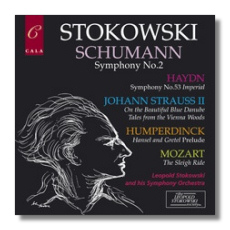
The Internet's Premier Classical Music Source
Related Links
- Schumann Reviews
- Latest Reviews
- More Reviews
-
By Composer
-
Collections
DVD & Blu-ray
Books
Concert Reviews
Articles/Interviews
Software
Audio
Search Amazon
Recommended Links
Site News
 CD Review
CD Review
Robert Schumann

Symphony #2
- Robert Schumann: Symphony #2 *
- Engelbert Humperdinck: Prélude to Hansel & Gretel
- Franz Joseph Haydn: Symphony #53 "The Imperial"
- Wolfgang Mozart: German Dance #3 "The Sleigh Ride"
- Johann Strauss:
- On the Beautiful Blue Danube
- Tales from the Vienna Woods
Leopold Stokowski Symphony Orchestra/Leopold Stokowski
Cala CACD0532 Rec. 1949, 1950*
Opulent: rich, luxuriant. This is how the Stokowski Sound is often categorized. That is true to an extent, but not always. Whilst the deep and rich bass line, a carryover from his days as an organist, is omnipresent there are differences in the Stokowski Sound, which are, however, unique to his art. This can be appreciated on this disc in many ways and a further comparison reveals even more how Stokowski's style differed at times.
Let me start with the Strauss music as an example of what I am talking about. Stokowski recorded these pieces in 1919/20, 26 and again in 1939. You can hear the '26 recordings on Biddulph 047 in transfers by Ward Marston. The Philadelphia performances are more "athletic" to quote Ed Johnson, the leading Stokowski expert. I also noted that the sound is not as opulent and the brass more to the fore. In these 1949 recordings the strings are much more forward and emphasized, though the brass is certainly there, and the portamento utilized more. The effect is that the gestalt has an MGM, Hollywood feel to it. This is not necessarily bad and is likely the result of Stokowski's own sojourn in California, hobnobbing with Disney. What is true of the sound on the Strauss can also be heard in the Humperdinck and Mozart (though these were his only recordings so I cannot do any comparative analysis)
There is a distinct difference in the Stokowski Sound when you turn to the Haydn and Schumann. While there is portamento here it is not as prominent as in the other music. Especially in the Haydn there is a lighter texture to the sound that is appropriate for a classical symphony. Possibly the orchestra was even smaller (or Stokowski didn't fiddle with the controls as much) Stokowski and his players sound as if they are discovering the music and having a wonderful time! The woodwinds are particularly delicious… if woodwinds can be eaten.
The Stokowski Sound also had a sonority that was perfect for the Schumann 2nd.
The adagio has a poignancy that is achingly beautiful. For some reason Elgar's name appears several times in my notes whilst listening to this movement. I don't know if that means anything, but there it is. Whoever that is on the kettledrums in the finale does a hell of a job! I can imagine an audience, were there one, jumping to their feet in applause.
As I have said in other reviews, HIS Orchestra (in some cases even billed as the Leopold Stokowski Symphony Orchestra) was an ad hoc band featuring some of the finest players in New York. It included Bob Bloom, Mason Jones, and Mitch Miller (of later "Sing Along" fame). The orchestra was small, usually no larger than 60 players, but after the recording was made Stokowski, as was his wont, would listen to them and tell the engineers what he wanted done to make it sound like 160! The advent of the use of tape enabled him to have the engineers add bass and otherwise create the Stokowski Sound. While a direct comparison with the New York Philharmonic at the time (heard on the other two discs released in 2002) reveals that this is a smaller band, it is not a small sound and far better than what Toscanini was getting from his vaulted NBC Symphony Orchestra at the time.
An excellent program featuring Leopold Stokowski in two fine, fine symphonic performances and opulent fillers.
You can contact the Leopold Stokowski Society at:
or via email at:
Copyright © 2002, Robert Stumpf II



















